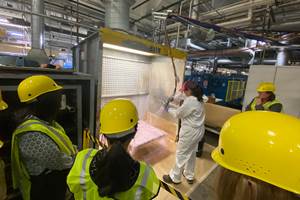Composites: Past, Present and Future: Marine Composites Training and Education, Part I
In Part I of a series about the past, present and future of training in marine composites, Andre Cocquyt outlines the historical difficulty composites manufacturers have had in finding qualified technicians, and how that reality led to his involvement in the development of training programs.
Share
When CT asked me to write an article about the past, present and future of training in marine composites, I found that, after a few draft attempts, I was going nowhere fast. Should I base it on my conversations with unhappy human resource personnel and shop managers? Should I refer back to the Marine Industry Technical Education Council (MITEC) meetings (established at the first Conference on Marine Industry Technical Training in 2005) where it became painfully clear that technical education at vocational-technical and community-college levels is not fulfilling our industry’s needs?
In the end, I decided to tell the story from my own myopic viewpoint: that of a boatbuilder who stumbled into training and found a new career. In the interest of full disclosure, I make a fair bit of my income as a private trainer, so I am not impartial. But it’s important to note that I became a trainer out of necessity because I could find no local program or school where I could send my employees. And the one nearby community college wasn’t receptive to my suggestion that they start a composites training program.
I was not alone. The main complaint of every composites industry manager I’ve talked to is the lack of skilled composites technicians. Obviously, the situation is not dire everywhere. A few local training programs exist. Ongoing successes include the one at Cerritos College (Norwalk, Calif.) under the leadership of Terry Price, and Mike Swietser’s program at Skagit Valley College’s Whidbey Island, Wash., campus. For most such college programs, however, program lifespan typically is limited. They are usually centered around an entrepreneurial teacher, and budget constraints and teacher recruitment problems can kill even the most promising programs, as happened recently at Martec in Moorhead City, N.C. Notably, Mike Swietser keeps his program alive — despite meager funding — by bartering and logging endless hours. I admire the perseverance and diligence of such pioneers. Further, I know several companies that have good in-house composites training programs. But these school-based and in-house programs are still exceptions.
As a rule, applicants for jobs in “lamination” at most boatbuilding companies today would be on the production floor within two hours of initial screening, and “new employee training” would take place under a “senior” worker. Within a few days they could get their own “station” and, as “senior” workers, get to train a new hire of their own.
On average, only two of every 10 new hires in the U.S. make it past their 90-day probation period. Annual attrition in the average composites boat shop is about 37 percent. The often unrecognized cost to a company for getting a “composites technician” trained to a fair level of professionalism is about $3,000 (USD). According to industry studies, there are about 125,000 composites technicians in the U.S. alone. Do the math, and it becomes clear that there is a big need for more and better training.
When I could not find the skilled help I needed, I created my own training program. It obviously worked, because my workers were hired away as fast as I could train them. After a while I closed shop and decided that there was a better living to be made as a trainer. Case in point, a nine-month training and conversion program that I conducted at Intermarine USA (Savannah, Ga.) not only netted me more than I’d made in a couple of years as a boatbuilder but turned Intermarine into a clean, well-organized shop with a significant reduction in employee attrition. And the program produced a big upswing in quality and productivity.
Other inquiries followed. Frankly, there was such a need for training in the composites industry that I’ve been on the road for about 200 days every year. This effort, however, was just the proverbial finger in a very leaky dike. For the past five years, I have helped develop training programs that are not teacher-dependent and, I hope, will have staying power. With support from vendors and distributors, to whom the industry has increasingly turned as an alternative training source, we took to the road with seminars, training DVDs and hands-on training sessions, meeting on the campuses of supportive colleges, in tents at composites conventions and in boatbuilders’ shops. Fifty-plus seminars and a few thousand attendees later, the program has started to make an impact on the industry, at least in the closed molding arena. But much more needs to be done.
In Parts II and II: Cocquyt describes a promising new initiative designed to produce a transferable blueprint for training composites technicians and discusses the importance of properly funding this educational initiative (see "Editor's Picks," at right).
Related Content
The Native Lab launches composites course training membership plan
Courses that touch on the fundamentals of composite materials, design, analysis and more are available for individuals and companies alike through TNL’s online platform.
Read MoreWomen in the Composites Industry brings together women for networking, educational opportunities
Aiming to support the growth of women in this industry, the WCI industry group and its partners recently held its first live training event hosted by Owens Corning.
Read MoreFACC Academy begins training, onboarding operations
FACC’s newly launched training platform will address skilled aerospace worker shortages head on, offering more than 250 specialized training courses for its entire workforce.
Read MoreZeiss, Imperial College London summer school enhances materials, sustainability learning
Twenty-four next-generation students attended the Imperial College London this August to advance their scientific knowledge, with workshops, lectures, activities and a composites competition.
Read MoreRead Next
Composites: Past, Present and Future: Marine Composites Training and Education, Part III
In Parts 1 and 2, Andre Cocquyt outlined the difficulty that composites manufacturers have faced in finding skilled employees and described a transferable model for local/regional training programs. In Part 3, he discusses the critical issue of program funding.
Read MoreComposites: Past, Present and Future: Marine Composites Training and Education, Part II
Last issue, in Part I, Andre Cocquyt identified the dire need for technical training in marine composites. In Part 2, he outlines a plan that could meet that need.
Read More“Structured air” TPS safeguards composite structures
Powered by an 85% air/15% pure polyimide aerogel, Blueshift’s novel material system protects structures during transient thermal events from -200°C to beyond 2400°C for rockets, battery boxes and more.
Read More









.jpg;maxWidth=300;quality=90)







